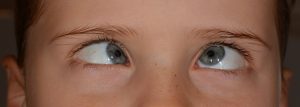Strabismus may persist or arise even in adulthood, when the decision to operate becomes very delicate, having to weigh both the potential functional and psycho-social benefits
Strabismus may persist or occur even in adulthood, when the decision to correct this defect surgically becomes very delicate, having to weigh up both the potential functional and psycho-social benefits
Strabismus: a complex visual pathology
Strabismus is an extremely common visual defect in children, but it can also sometimes be present in adulthood, either as a residual of a childhood strabismus or due to ex-novo onset in adulthood. About 4-5% of the population is affected by strabismus.
Strabismus consists of a deviation of the ocular axescaused by various causes, which can manifest itself as a convergent deviation (exotropy), divergent (exotropy), vertical (hyper- or hypotropia) or torsional (cyclotropy).
Motor impairments frequently result in correlated sensory changes, leading to changes in binocular vision, resulting from normal cooperation between the two eyes, and/or to a reduction in the visual acuity of one or both eyes (amblyopia).
Let us recall that amblyopia, commonly known as 'lazy eye', is determined by an aberrant competitive interaction between the cortical afferent fibres of the two eyes, this condition results in one of the eyes becoming dominant and the other 'lazy' losing visual acuity.
Some forms of strabismus resolve spontaneously and do not require any treatment, while others require glasses, and in many cases surgery is the only solution.
Causes of squinting
The pathogenesis of strabismus remains largely unknown, and several, often opposing, theories have been formulated to explain the childhood form of esotropia.
Hereditary components
 There is undoubtedly a significant hereditary component underlying concomitant strabismus; in fact, familial clustering was described by Hippocrates as early as around 400 BC, and confirmed by more modern studies conducted on families and twins. It has been estimated that the relative risk for first-degree relatives of a proband with strabismus is approximately between 3 and 5; heredity remains significant even after correction for environmental risk factors.
There is undoubtedly a significant hereditary component underlying concomitant strabismus; in fact, familial clustering was described by Hippocrates as early as around 400 BC, and confirmed by more modern studies conducted on families and twins. It has been estimated that the relative risk for first-degree relatives of a proband with strabismus is approximately between 3 and 5; heredity remains significant even after correction for environmental risk factors.
Genetic variants
The study "Genome-Wide Association Study Identifies a Susceptibility Locus for Comitant Esotropia and Suggests a Parent-of-Origin Effect.", published in 2018 by Sherin Shaaban et al. su Investigative Ophthalmology & Visual Sciencefocused on esotropia by investigating the genetic variants that confer greater susceptibility to this form of strabismus, which is believed to be inherited as a complex trait and has its highest incidence in European populations.
The genome-wide approach
The study enrolled approximately 1,200 patients, Americans of white European descent and mostly seen at Boston Children's Hospital. The researchers conducted on these patients a genome-wide association study (GWAS), never previously used to investigate exotropy. GWAS, a relatively recent technique, investigates cohort genomes or large populations using well-known genetic markers such as SNPs (Single Nucleotide Polymorphism). This type of analysis can be useful for detecting genetic variants that influence common traits such as height, obesity, diabetes or hypertension.
The polyphorphism identified
Normally the data obtained with GWAS are in the order of tens of hundreds of results, but the analysis of exotropy conducted in this study produced only one. An association of exotropy with a single polymorphism, differentially methylated, located within intron 1 (non-coding genetic region) of the WRB (tryptophan rich basic protein) gene located on chromosome 21 was highlighted. WRB is an 'imprinted' gene, i.e. its expression varies depending on the parent from which it is inherited. In this sense, the study showed a statistically significant bias towards paternal inheritance, i.e. patients with strabismus were more likely to have inherited the WRB gene variant from their father. Furthermore, WRB is located on chromosome 21, and children with trisomy 21 (or Down syndrome) have a higher incidence of squinting, a connection the researchers found interesting.
Childhood squinting
Untreated childhood strabismus can cause severe visual impairment in the deviated eye and the failure to develop normal binocular vision.
Often, as a first resort, the use of an eye patch (occluder) to be applied over the 'straight' eye is recommended, in order to stimulate the deviated eye and avoid the development of amblyopia, commonly referred to as 'lazy eye'.
In most cases, the strabismic child does not show any signs of visual difficulties, nor does he or she behave differently from any other child, which may lead the parent to mistakenly postpone the first visit to the beginning of primary school.
Squinting in adults
 Strabismus arising in adulthood may be a consequence of metabolic disorders, or secondary to neurological disorders, or be the consequence of trauma or more or less important sensory deficits.
Strabismus arising in adulthood may be a consequence of metabolic disorders, or secondary to neurological disorders, or be the consequence of trauma or more or less important sensory deficits.
Sometimes, ageing causes a change in the soft tissue around the eye, which is among the contributing causes of strabismus in the elderly.
This type of strabismus generally has an acute symptomatology, particularly in cases of misalignment that appear suddenly in adulthood, patients almost always complain of double vision.
In adults, it is possible to adopt some of the corrective therapeutic approaches used for children, such as the use of prismatic glasses, the practice of specific exercises to regain coordination of both eyes (functional exercises) and, as a last resort, resorting to surgery.
Strabismus surgery
Surgery has theobjective of realigning the visual axes by acting on the muscles that control the eyes. To do this, it is necessary to change the force with which the muscles are able to make the eyeballs move.
To this end, it is possible:
- “Reinforce" a muscle by shortening it through a plication operation
- “Weaken him" through recession intervention
Frequently, strabismus surgery is part of a complementary therapeutic course, which includes correction with glasses of any other refractive defect, rehabilitation therapy of any amblyopia through occlusion, or other non-surgical therapies that complement each other and prepare the patient for the best post-surgical outcome.
Cosmetic or functional surgery?
Strabismus correction surgery is usually performed in an outpatient setting and is not particularly painful. However, a very sensitive issue is whether the decision to surgically correct strabismus in adults should be guided primarily by a functional purpose or can be taken for psychological and aesthetic reasons.
Psychosocial' symptoms
Suffering from strabismus leads to so-called 'psychosocial symptoms', which result in a lower quality of life than people without the condition.
Strabismus patients have been found to be 10 times more likely to suffer from clinical anxiety or depression, sociophobia' (social anxiety disorder) and a tendency to avoid all social contact, difficulty making eye contact and interacting with other people through gaze, embarrassment, self-defeat, difficulty establishing friendship and social relationships
While from a functional point of view, surgical realignment of the eyes in adults aims to improve double vision, depth perception and sometimes the field of peripheral vision, on an emotional, social and psychological level, eye realignment can help restore a normal facial appearance and ensure a better quality of life.
Psychosocial outcomes of strabismus surgery
A systematic review of the scientific literature available between 1946 and 2023 was published in April 2024, Strabismus Surgery for Psychosocial Reasons-A Literature Reviewto evaluate the evidence of postoperative outcomes in adult patients, aged over 18 years, who underwent strabismus surgery for psychosocial reasons.
Sixty-nine studies were considered, with reference to heterogeneous cohorts of surgical patients with strabismus.
The results show that most adults who underwent strabismus surgery for psychosocial reasons achieved significantly better postoperative ocular alignment and a consequent improvement in related quality of life.
Positive results were noted as early as three months after surgery. Other positive outcomes such as enlargement of the visual field, improvement of near vision and binocular vision, better performance in the movement of both eyes and in the performance of daily activities have been reported but not systematically investigated.
Furthermore, it would be necessary to promote a consensus on which objective parameters to adopt to measure the postoperative success of strabismus surgery, especially if it is decided for psycho-social reasons.
Complications
The most common risks of complications of strabismus surgery are residual misalignment of the eyes and diplopia.
Most diplopia after strabismus surgery is temporary. Persistent residual double vision is possible, which is corrected by the use of prisms.
Fortunately, the most serious risks are rare and include complications of anaesthesia, scarring in the white part of the sclera, infection, numbness of the eyelids, bleeding, retinal detachment and reduced visus.
In most cases, patients return to normal daily activities within a few days, while swimming and heavy physical activities should be avoided, at least for a few weeks after surgery.
On the subject of strabismus, see also:
- A frequent visual defect: strabismus - Oculista Italiano
- Strabismus heredity - Italian Ophthalmologist
- Arblaster G, Buckley D, Barnes S, Davis H. Strabismus Surgery for Psychosocial Reasons-A Literature Review. Br Ir Orthopt J. 2024 Apr 22;20(1):107-132. doi: 10.22599/bioj.352. PMID: 38681188; PMCID: PMC11049605.
- Beauchamp, GR, Black, BC, Coats, DK, Enzenauer, RW, Hutchinson, AK, Saunders, RA, ... Felius, J. 2003. The management of strabismus in adults-I. Clinical characteristics and treatment. J AAPOS, 7(4): 233-240. DOI: 10.1016/S1091-8531(03)00112-5
- Estes, KJ, Parrish, RK, Sinacore, J, Mumby, PB and McDonnell, JF. 2020. Effects of corrective strabismus surgery on social anxiety and self-consciousness in adults. J AAPOS, 24(5): 280.e281-280.e284. DOI: 10.1016/j.jaapos.2020.05.017
- Serafino, M, Granet, DB, Kushner, BJ, Dagi, LR, Kekunnaya, R and Nucci, P. 2019. Use of the Delphi process for defining successful outcomes for strabismus surgery. J AAPOS, 23(6): 309-312. DOI: 10.1016/j.jaapos.2019.07.006
